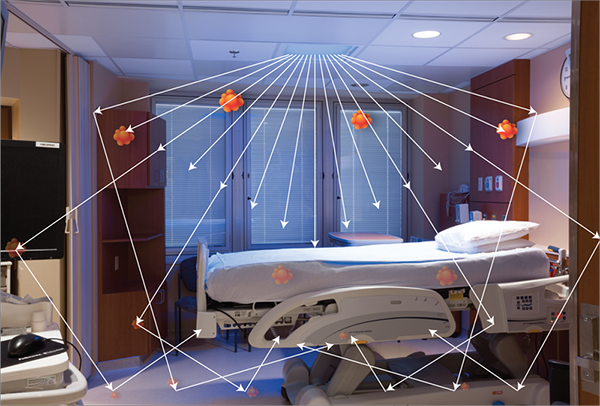 A pathogen-killing light fixture developed at the University of Strathclyde in Glasgow, Scotland has now been made into a product and is being introduced in hospitals in the U.S. and Canada.The Indigo-Clean, made by Kenall Manufacturing out of Kenosha, Wisconsin, is installed into the ceiling like any other light fixture and when activated emits light at a wavelength of 405 nm. The indigo light, not quite in the range of the more dangerous ultraviolet light, causes bacteria to produce reactive oxygen species, halting their growth and reproductive abilities.
A pathogen-killing light fixture developed at the University of Strathclyde in Glasgow, Scotland has now been made into a product and is being introduced in hospitals in the U.S. and Canada.The Indigo-Clean, made by Kenall Manufacturing out of Kenosha, Wisconsin, is installed into the ceiling like any other light fixture and when activated emits light at a wavelength of 405 nm. The indigo light, not quite in the range of the more dangerous ultraviolet light, causes bacteria to produce reactive oxygen species, halting their growth and reproductive abilities.

Microbial contamination on a contact agar plate with a 405nm light source in the background. Credit: University of Strathclyde
The light is supposedly safe enough to be left on continuously to provide all-day protection against pathogens on surfaces and floating in the air. The fixture is available in three varieties, depending on the facility’s needs: blended white, indigo-only, or switchable white/indigo.
From the announcement:
This High-Intensity Narrow Spectrum (HINS) light is absorbed by molecules within bacteria, producing a chemical reaction that kills the bacteria from the inside as if common household bleach had been released within the bacterial cells. Because the light is visible, it is lethal to pathogens but can be used safely in the presence of patients and staff.
Evaluation of the technology, as part of Strathclyde’s clinical engagement programme, has been ongoing since 2008. The technology and its effectiveness have been the subject of more than 20 peer-reviewed academic publications and 30 conference presentations since then. Strathclyde was granted US patents on the technology in 2012 and 2015 and the licence agreement provides Kenall with rights for the North American healthcare market.
Link: Indigo-Clean technology page…
Source: University of Strathclyde…
The post Pathogen Killing Light Fixture Kills Bugs on Surfaces and in Air appeared first on Medgadget.
